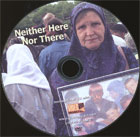
Neither Here nor There 2009
Distributed by The Video Project, PO Box 411376, San Francisco, CA 94141-1376; 800-475-2638
Produced by Kerri Yost, Beth Pike, Stephen Hudnell, Elizabeth Federici
Directed by Kerri Yost, Beth Pike, Stephen Hudnell, Elizabeth Federici
DVD, color, 58 min.
Sr. High - Adult
Human Rights, International relations, Holocaust and Genocide Studies
Date Entered: 08/18/2010
Reviewed by Brian Falato, University of South Florida Tampa Campus LibraryNeither Here nor There focuses on the Selimovic family, Bosnian Muslim refugees who have been relocated to Columbia, Mo. Fatima Selimovic lost her husband and father in the 1992-1995 war in Bosnia, in which ethnic Serbs attempted to eliminate the Bosnian Muslim population and make Bosnia part of a Greater Serbia. Fatima’s husband was an early casualty in the war, shot in a barn by Serbs. Her father was among the 8000 men and boys executed by the Bosnian Serb Army in a roundup of male Muslims in Srebrenica, Bosnia, which ironically had been designated a “safe zone” by the United Nations and to which refugees flocked.
The video traces the activities in Missouri of Fatima and her three teenage children. Fatima works as a hotel housekeeper. The older daughter, who has an infant son, is seen graduating from high school and being reunited with her Bosnian husband. The three children talk about their experiences living in America. The video also shows Fatima’s return to Bosnia after her father’s remains have been positively identified. Each year, a memorial service is held for the Srebrenica massacre victims who have been identified through DNA evidence, and the families are able to properly bury their loved ones.
The co-director and narrator of the video is Kerri Yost, who is the refugee caseworker for the Selimovic family. She and her co-directors keep the story on a very personal level. There is no journalistic background or investigation in the video. This proves to be a major drawback. We never find out how and why the Selimovic family got to Columbia, Mo., or why St. Louis is the city with the largest Bosnian population outside of Bosnia. We don’t hear about any struggles this Muslim family may have living in a post-9/11 America. And although the Srebrenica massacre is brought up, there’s no background as to how this was allowed to happen in an area designated a safe zone.
The video lists funding sources from several institutions in Missouri, and it’s possible the directors were thinking of their local audience and not trying to place the story in a larger context. But as a result, the video is seriously deficient as an educational tool on the Bosnian war and the problems of refugees in America. This video is more for public or high school libraries as a way to introduce the idea of war refugees living in their community by personalizing the story through one family.